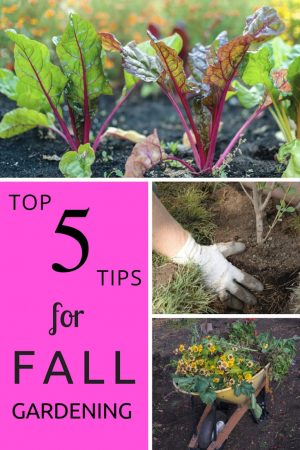Top 5 Tips For Fall Gardening

Summer’s over but that doesn’t necessarily mean the year’s gardening is over. You can keep those crops coming if you want to. But even if you don’t feel like planting, there are plenty of tasks to do in the backyard to keep busy outdoors. Here are 5 tips for fall gardening:
1. Clean up the garden. The summer harvest can be frantic, especially toward the end of the season, and a few veggies surely were forgotten. You may have bolted lettuce, wilting tomato stalks or scattered beans. The soil is likely depleted of nutrients too. You know you’ll have to clean that up now or later, so do it now. Add those leftover or rotting veggies to the compost pile, and add some of the processed compost on the soil to work it in. Before you do, pull out all weeds then loosen and turn the soil.
2. Put in a fall garden. The cool, crisp days of autumn appeal to some vegetables, but not all. Don’t waste your time trying for another tomato harvest, but opt for veggies that do better with a touch of fall’s cool weather. Vegetables that taste better when grown in cool weather include broccoli, cabbage, cauliflower and kale. You’ll need to start them in summer, however, to ready the seedlings for fall planting. On the other hand, sow broccoli raab, spinach, chard, lettuce and peas directly into the newly tidied garden.
3. Plant a garden in warm zones. If you live in a warm area, like U.S. Department of Agriculture plant hardiness zones 8 and above, fall is your optimal gardening season. Put in a garden now and your crops and harvest can extend through spring.
4. Put in a cover crop. If you’re gardened out for the calendar year, consider seeding a cover crop, also called “green manure.” These crops can include clover, annual ryegrass, winter wheat, winter rye or buckwheat. Why are they called green manure crops? Because in the spring you turn these crops into the soil to provide organic matter and precious nutrients. They do double duty since they prevent erosion and the spread of weeds too.
5. Plant trees. You don’t have to be Johnny Appleseed to install trees and shrubs in autumn. Many believe that September through early October is the ideal planting time, though other experts extend this through November. Trees transplanted during autumn get rain water to drink, but irrigate during dry weather. These trees will establish their roots in the new site before winter.
See more at…https://blog.gardeningknowhow.com/top-of-the-crop/top-5-tips-fall-gardening/